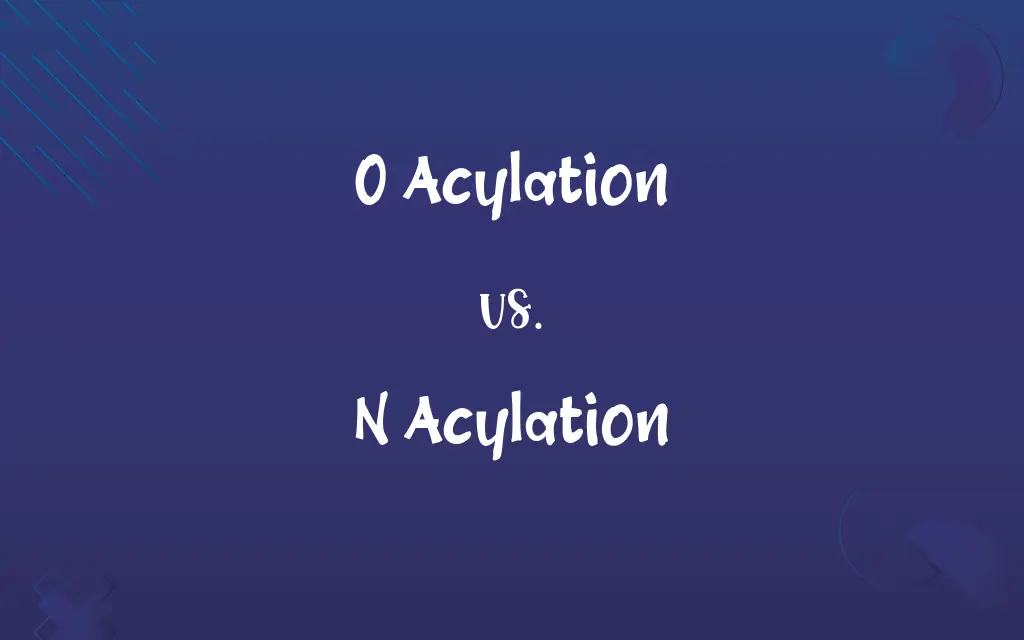O Acylation vs. N Acylation: Know the Difference

By Dua Fatima & Hifza Nasir || Published on March 29, 2024
O-Acylation involves attaching acyl group to oxygen atom, commonly forming esters, while N-Acylation attaches acyl group to nitrogen atom, typically resulting in amides; each process influences properties & reactivity of resultant compounds differently.

Key Differences
O-Acylation and N-Acylation are both key organic synthesis reactions that introduce an acyl group (RCO-) to molecules, but they differ in their nucleophilic targets—oxygen for O-Acylation, leading to esters, and nitrogen for N-Acylation, producing amides. This difference in nucleophilic site affects the stability, reactivity, and applications of the products.
Hifza Nasir
Mar 29, 2024
The mechanisms of these reactions typically involve nucleophilic attack on the carbonyl carbon of the acyl chloride or anhydride by either an alcohol (in O-Acylation) or an amine (in N-Acylation). O-Acylation requires a good leaving group, often producing esters in the presence of a base, whereas N-Acylation can proceed under milder conditions due to the higher nucleophilicity of nitrogen.
Hifza Nasir
Mar 29, 2024
O-Acylation products, esters, are characterized by their pleasant odors and are widely used in flavors, fragrances, and as solvents. N-Acylation leads to amides, which are more polar, typically resulting in higher boiling points and greater solubility in water, reflecting in their use in pharmaceuticals and polymers.
Dua Fatima
Mar 29, 2024
The choice between O-Acylation and N-Acylation in synthetic routes depends on the desired product's properties. For instance, O-Acylation is preferred for synthesizing esters for perfumes and plastics, while N-Acylation is crucial for drug synthesis and polymer manufacturing, highlighting the importance of the target molecule's functional group in determining the reaction pathway.
Dua Fatima
Mar 29, 2024
Both reactions are fundamental in organic chemistry for constructing complex molecules. They illustrate the versatility of acyl groups in forming a wide range of compounds, each with distinct properties and applications, underscoring the tailored approach needed in chemical synthesis.
Shumaila Saeed
Mar 29, 2024
ADVERTISEMENT
Comparison Chart
Product Properties
Pleasant odors, used in flavors and fragrances
Higher boiling points, used in pharmaceuticals
Hifza Nasir
Mar 29, 2024
ADVERTISEMENT
Stability
Generally stable, hydrolyzed by strong bases
More resistant to hydrolysis
Dua Fatima
Mar 29, 2024
Reactivity
React with nucleophiles and reducing agents
Less reactive towards nucleophiles
Dua Fatima
Mar 29, 2024
Solubility
Variable, often soluble in organic solvents
Generally higher solubility in water
Hifza Nasir
Mar 29, 2024
Synthesis Complexity
Can be straightforward or complex
Often requires specific catalysts or conditions
Dua Fatima
Mar 29, 2024
Key Differences in Usage
Preferred for synthesizing esters for perfumes
Crucial for drug synthesis and polymer manufacturing
Hifza Nasir
Mar 29, 2024
ADVERTISEMENT
O Acylation and N Acylation Definitions
O Acylation
Commonly produces esters with distinct odors.
O-Acylation of 1-butanol with acetic anhydride yields butyl acetate, used in fruit flavorings.
Dua Fatima
Feb 26, 2024
N Acylation
A process where an acyl group is attached to a nitrogen atom, typically producing amides.
The reaction of acetic anhydride with ammonia or an amine forms acetamide.
Dua Fatima
Feb 26, 2024
O Acylation
A reaction where an acyl group is bonded to an oxygen atom, forming esters.
Acetic anhydride acylates ethanol to produce ethyl acetate.
Dua Fatima
Feb 26, 2024
N Acylation
Essential for the synthesis of pharmaceuticals.
N-Acylation of aniline with acetyl chloride yields acetanilide, a pain reliever precursor.
Hifza Nasir
Feb 26, 2024
O Acylation
Requires conditions that favor nucleophilic attack on carbon.
The synthesis of aspirin from salicylic acid and acetic anhydride is an example of O-Acylation.
Hifza Nasir
Feb 26, 2024
N Acylation
Results in amides used in drug synthesis and polymers.
N-Acylation of 6-aminopenicillanic acid with various acyl chlorides produces different penicillin antibiotics.
Dua Fatima
Feb 26, 2024
O Acylation
Used in synthesizing esters for flavors and fragrances.
Benzoyl chloride reacts with methanol in O-Acylation to form methyl benzoate.
Hifza Nasir
Feb 26, 2024
N Acylation
Can be performed under mild conditions due to nitrogen's nucleophilicity.
The production of penicillin derivatives often involves N-Acylation steps.
Dua Fatima
Feb 26, 2024
O Acylation
Involves the use of acyl chlorides or anhydrides as reactants.
Propionic anhydride's reaction with glycerol demonstrates O-Acylation, forming propionyl glycerol.
Dua Fatima
Feb 26, 2024
N Acylation
Utilizes amines or ammonia as nucleophiles.
Benzoyl chloride reacts with ammonia in N-Acylation to form benzamide.
Hifza Nasir
Feb 26, 2024
Repeatedly Asked Queries
How does the nucleophilicity of nitrogen influence N-Acylation reactions?
Nitrogen's higher nucleophilicity compared to oxygen allows N-Acylation to proceed under milder conditions and with greater specificity.
Dua Fatima
Mar 29, 2024
How does the choice of catalyst affect N-Acylation reactions?
Catalysts can significantly affect the rate, selectivity, and yield of N-Acylation, enabling more efficient and environmentally friendly processes.
Shumaila Saeed
Mar 29, 2024
What are the typical reagents used in O-Acylation?
Common reagents include acyl chlorides, acid anhydrides, and carboxylic acids under specific conditions.
Dua Fatima
Mar 29, 2024
What are the environmental implications of O-Acylation and N-Acylation?
Both reactions can involve hazardous reagents and produce waste; however, green chemistry approaches are being developed to minimize their environmental impact.
Hifza Nasir
Mar 29, 2024
What distinguishes O-Acylation from N-Acylation at a molecular level?
O-Acylation involves the attachment of an acyl group to an oxygen atom, forming esters, while N-Acylation involves attachment to a nitrogen atom, forming amides.
Hifza Nasir
Mar 29, 2024
Can both O-Acylation and N-Acylation occur in the same molecule?
Yes, molecules containing both hydroxyl and amino groups can undergo both O-Acylation and N-Acylation, leading to complex functionalization.
Dua Fatima
Mar 29, 2024
Why are esters commonly produced through O-Acylation used in fragrances?
Esters have pleasant, often fruity odors, making them ideal for use in fragrances and flavors.
Dua Fatima
Mar 29, 2024
What role do O-Acylation and N-Acylation play in pharmaceutical synthesis?
N-Acylation is crucial for synthesizing amides, which are key components in many drugs, while O-Acylation can be used to modify drug properties or synthesize prodrugs.
Hifza Nasir
Mar 29, 2024
Why is solubility important in the context of O-Acylation and N-Acylation products?
The solubility of the products affects their application and processing, with esters often being soluble in organic solvents and amides in water, influencing their use in various industries.
Hifza Nasir
Mar 29, 2024
Can O-Acylation and N-Acylation be reversed?
Yes, both processes can be reversed under specific conditions, typically through hydrolysis, allowing the recovery of the alcohol or amine and the acyl group donor.
Hifza Nasir
Mar 29, 2024
Share this page
Link for your blog / website
HTML
Link to share via messenger
About Author
Written by
Dua FatimaCo-written by
Hifza Nasir







































































